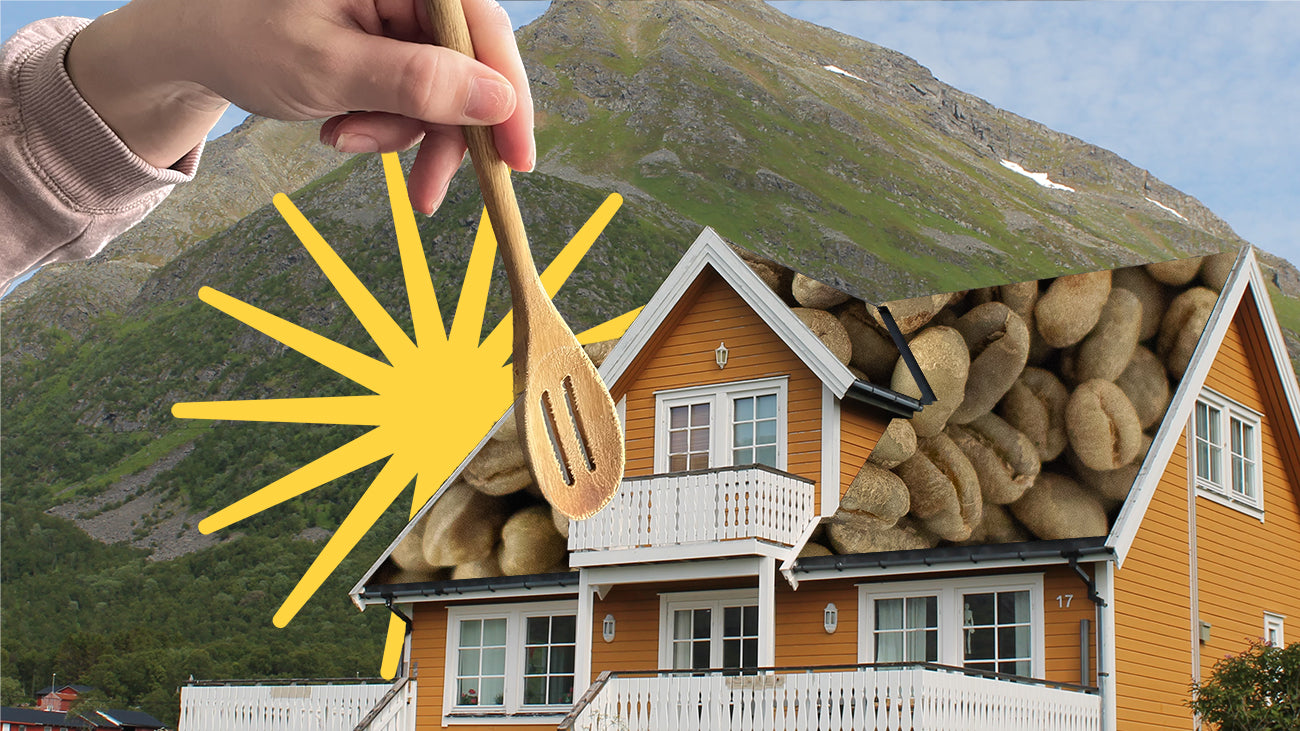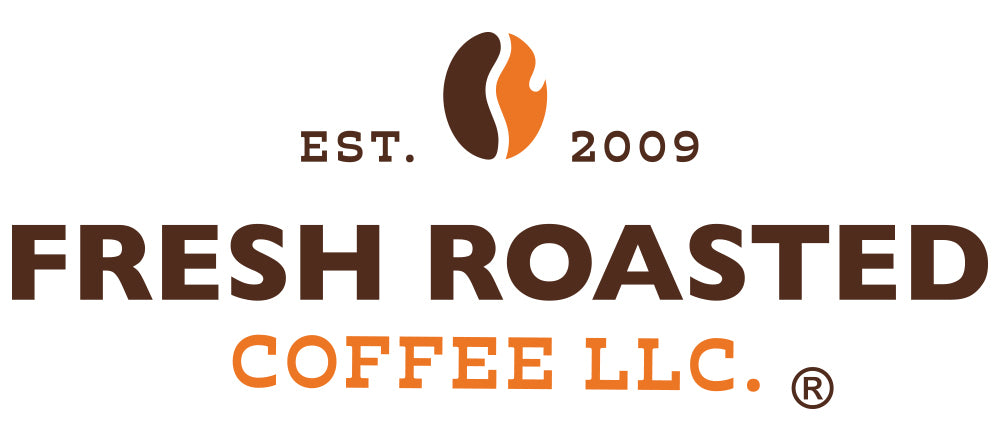A Beginner’s Guide to Roasting Coffee at Home

If you're any kind of a coffee drinker, café frequenter, or machinery enthusiast, there's a good chance you've basked in the glorious radiance of a coffee roaster—the mass of cast-iron and stainless-steel from which all good things come. Well, one good thing: coffee.
Without these commercial roasters (think Loring, Diedrich, Probat), we wouldn't have tasty, roasted coffee. We'd have to chew the beans whole.
Here at Fresh Roasted Coffee, we use Loring Smart Roasters, which are the most eco-friendly roasters on the planet. We have cut our carbon emissions and fuel consumption by up to 80% in a smokeless roasting environment, using this advanced roasting technology to enhance overall coffee bean flavor, quality, and roasting precision. Only the best for our customers.
Have you ever thought of roasting your own coffee at home? Not sure how to get started? Don't want to drop thousands of dollars on an S7 Nighthawk? We don't blame you. No home roaster starts on a top-of-the-line machine. No, most come from humbler beginnings, like, say, a cast-iron skillet and a wooden spoon. Such was the case for our very own Roastmaster, Dave Jackson. We all gotta start somewhere.
Should I Try Roasting Coffee at Home?
If you've been toying with the idea of roasting your own coffee, go for it. If you have any of the “roasters” listed below (and we suspect you do), all you need to do is buy the coffee, which is cheaper than roasted coffee. Start with a pound of Colombian Supremo or Brazil Cerrado and see how it goes, as they're both stellar coffees on their own, solid bases for blends, and taste great at several different roast levels. In short, they're reasonably forgiving. To celebrate starting, coffee, and the fun-filled road ahead, here are eight alternative ways to roast green coffee that don't require a commercial roaster.
Warning: Roast at your own risk. Home coffee roasting can be hazardous to your health and property if not done with care. Always roast in a well-ventilated area away from flammable material. Having a fire extinguisher on hand is recommended. Start by roasting outdoors until you know how much smoke and chaff to expect.
-
Fresh Roast SR800 or SR540 Home Coffee Roaster

While home roasting is rewarding, it is not without its difficulties. If you'd like to save yourself some hassle from the get-go, we recommend picking up an SR800 or SR540. These home roasters are compact yet powerful. With the SR800, you have the choice of nine different levels of heat with a large roasting chamber capable of charging up to 8 oz. of unroasted coffee. While these home roasters appear simple, having only three buttons and an adjustment dial, there's much more to them. A quick turn of the knob will show your current temperature. Pressing the dial button toggles through temperature and fan speed. Speaking of which, the SR800 can cool your roast in minutes, saving you the headache of over-roasting or, if you feel as though your roast is getting too dark, starting a fire.
If you're not ready to make that investment, though, there are several ways to roast coffee at home with equipment you probably already have.
-
Cast-Iron Skillet

There's a good chance you've got a cast-iron skillet somewhere in your house. How it's seasoned, however, is a completely different story. If you last cooked bacon in it, you're in for some unintended tasting notes in your coffee, unless you're into that kind of thing. A pan pre-seasoned with olive oil, dried, and stirred with a wooden spoon is best. Ventilation is essential here. You're applying insane heat to dry beans—there will be a lot of smoke. Keep your coffee moving for the most even roast possible and pay attention to the color.
We recommend roasting on a camp stove in the yard or in your garage with the doors wide open. And since there's nowhere for the chaff to go, you'll have to sift it out later by shaking your roast in a mesh sieve. Maybe you'll get lucky and a gentle breeze will carry the chaff away.
-
Whirley Pop

Eventually, Dave graduated to a Whirley Pop popcorn popper, a stainless-steel stovetop popper with a hand crank, so you can easily turn your beans as they roast. How many times can we say “pop”? Unlike the cast-iron-wooden-spoon method, the Whirley Pop allows you to agitate more evenly and consistently, leaving you with a more homogenous roast. Keep in mind, though, that some of your first roasts will likely be all over the place: some beans will be very light, some very dark, some burned to a crisp. It's all part of the process. Dave has had his fair share of bad batches. It happens to the best of us.
Though this is a stovetop “roaster,” there will still be smoke, so turn that range hood fan on. When you're satisfied with your roast, take it outside to sift out the chaff and cool the beans down to room temp. The faster you cool the coffee, the better—a box fan helps.
-
Air Popcorn Popper

By now, your roasting arm must be getting tired, what with all the stirring and cranking. If you're ready to start working smarter, not harder, look no further than an air popcorn popper. You know, the ones where the popcorn comes out the top and falls into your bowl or, alternatively, all over the counter? You can probably pick one up at the thrift store for under $5. You can use them for coffee, and you don't have to crank anything or wield a large spoon, but you do have to closely monitor the temperature, color, and aroma.
You'll want an air popper with side vents, as the models that vent to the bottom can become clogged with chaff and catch fire. Speaking of chaff, it's gonna fly everywhere, so we recommend roasting outside.
-
Oven

You make your favorite lasagna in the oven, so why wouldn't you roast your favorite coffee there, too? Dave had never heard of anyone roasting (baking, I guess) coffee in an oven, but that didn't stop him from smoking up his whole house with a solid college try. You'll invariably have a smoke show on your hands, so make sure your doors and windows are wide open and that your range hood fan is on full blast.
Roasting in your oven is by far the cheapest home-roasting avenue, but it is also one of the most challenging. You'll be opening the door, donning your oven mitts, pulling the cookie sheet out, redistributing the beans, making sure everything's in a single layer, and on and on. Commercial roasting starts low and gradually gets hotter before dropping back down. Ovens are just hot throughout and can't increase temperature rapidly, so all those nuanced flavors hiding in the beans won't present well. You might get a good dark roast, but that's about it.
-
Air Fryer

The air fryer was invented in 2010 to free busy people from long cook times. It not only warms up chicken tenders in 10 - 15 minutes, but the air fryer can also roast coffee in roughly the same amount of time. Air-fried coffee benefits from the continuous hot air being blown around it, making for relatively even light and medium roasts. In the case of dark roasts, most air fryers max out at 450°F, which isn't quite hot enough to make that final leap into dark roast territory. If you're itching to experiment with small-batch home roasting, the air fryer might be a good place to start.
Start by placing your mesh or metal grate into the basket and preheating your air fryer for 3 - 5 minutes at 450°F. Add your coffee, set the timer for 15 minutes, and start the roast. First crack should come around 10 minutes. Monitor the progress of your roast closely. To avoid excessive chaff buildup, we recommend pulling the basket out once every minute and agitating the beans to make sure they all get evenly roasted. Doing this will throw chaff everywhere, so your garage or backyard are the best places to roast.
-
Hot Coals

How coffee was originally roasted, this method of heating the beans in a metal pan over smoldering coals is still in practice today. In fact, it's integral to African coffee ceremonies, which are quite lengthy (up to three hours) and involve washing a coffee by hand, roasting, grinding, and brewing it. Unlike an open flame, hot coals produce more even heat.
As the coffee is roasting and being ground, a special brewing vessel called a jebena is filled with water and placed in the coals. A jebena features a long neck, round base, and a thin pouring spout. If you're an outdoorsy person who likes coffee and is confident enough to toss some beans in the fire, this would be a solid test of your skills. Africa has been doing it for centuries, so don't feel too bad if you goof up your first roast.
-
Deep Fryer

At the tail end of 2022, World Barista Champion and professional coffee person James Hoffmann posted a YouTube video titled Deep Fried Coffee: A Horrifying Discovery. The thumbnail alone—a basket of roasted coffee dripping with oil—is enough to draw you in and gross you out. He started by charging 100g of a washed Ethiopian coffee into approximately 340°F oil. The coffee's roast progression when deep frying it is difficult to track, particularly by color. From the video, you can see the “roast” (or fry) is all over the place. Some beans are underdeveloped, some nearly black, and many at different points in the middle.
After screening out all the duds, James made a pour over. The oils didn't clog the filter, nor did the resulting cup taste bad. “That's good? That's good. That's good!” he said. Though slightly underdeveloped, the texture was soft, rich, and rounded, with little acidity. To further test the beans, he pulled it as espresso, which came out cloudy, crema-less, and “disgusting,” he said, looking visibly pained before taking another sip.
Just as there's no right way to brew coffee, there's no right way to roast coffee, if you do it with immense care and common sense. Roasting your own beans gives you much more control over the flavor profile of your cup. It can be tough, but I promise it's one of the most rewarding coffee things you can do. So have fun, be careful, and let us know how it goes.
Warning: Roast at your own risk. Home coffee roasting can be hazardous to your health and property if not done with care. Always roast in a well-ventilated area away from flammable material. Having a fire extinguisher on hand is recommended. Start by roasting outdoors until you know how much smoke and chaff to expect.



Leave a comment